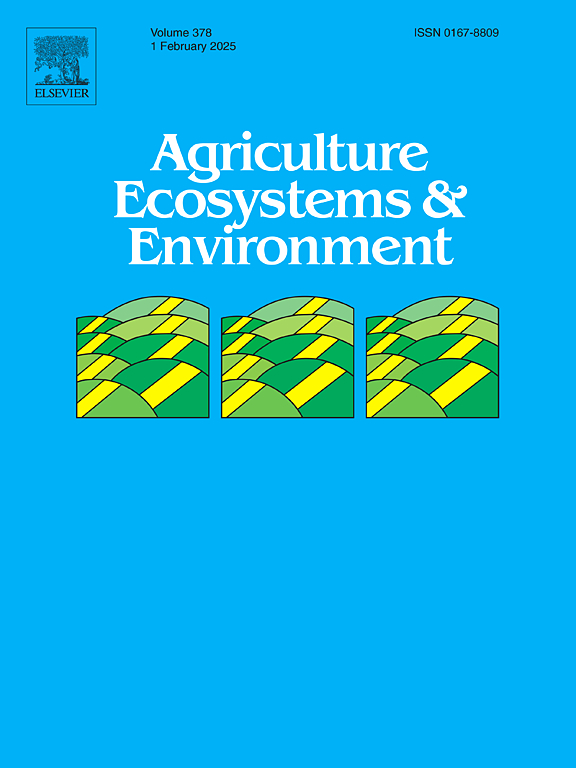Comparative pollinator conservation potential of coffee agroforestry relative to coffee monoculture and tropical rainforest in the DR Congo
IF 6
1区 农林科学
Q1 AGRICULTURE, MULTIDISCIPLINARY
引用次数: 0
Abstract
Animal-pollination is crucial in the reproduction of many crops grown in the tropics, including the self-incompatible Robusta coffee. Coffea canephora Pierre ex A. Froehner. is indigenous to the Congo basin where it is naturally growing in the rainforest understorey. Coffee cultivation mainly occurs in either unshaded monocultures or in agroforestry systems. Here we used pan traps to survey the Diptera (true flies) and Hymenoptera (bees) communities as the putative coffee pollinating organisms in the Yangambi region in DR Congo, and we assessed the comparative benefits of a coffee agroforestry system and coffee monoculture to the coffee pollinator community. To assess the pollinator conservation potential of the agroforestry system, we also compared its Diptera and Hymenoptera communities with natural rainforest as a benchmark. Natural rainforest harboured a higher number of individuals, as well as a higher number of species than both agroforestry and coffee monoculture systems, with no differences between the latter two land-uses. Furthermore, we observed different responses in species richness and diversity to land-use between Diptera and Hymenoptera. Our analyses further showed a high species dissimilarity between natural rainforest and the two cultivation systems, without significant differences between the latter. Specifically, the community composition of the agroforestry and coffee monoculture systems were totally different, rather than a subset of the community composition of the natural rainforest. Our study indicates that rehabilitation of agricultural land through intercropping fruit trees may not always enhance pollinator communities and that the studied agroforestry system falls short of matching the bee and fly conservation potential of natural rainforests.
刚果(金)咖啡农林业相对于咖啡单一种植和热带雨林的授粉者保护潜力比较
动物授粉对热带地区许多作物的繁殖至关重要,包括自交不亲和的罗布斯塔咖啡。Coffea canephora Pierre ex A. Froehner.Froehner. 是刚果盆地的原生植物,自然生长在热带雨林林下。咖啡种植主要在无遮蔽的单一种植园或农林系统中进行。在此,我们使用盘式诱捕器调查了刚果民主共和国扬甘比地区的双翅目(真蝇)和膜翅目(蜜蜂)咖啡授粉生物群落,并评估了咖啡农林系统和咖啡单一种植对咖啡授粉生物群落的比较效益。为了评估农林系统保护授粉生物的潜力,我们还将其双翅目和膜翅目群落与作为基准的天然雨林进行了比较。与农林系统和咖啡单一种植系统相比,天然雨林中的个体数量和物种数量都更多,后两种土地利用方式之间没有差异。此外,我们还观察到双翅目和膜翅目的物种丰富度和多样性对土地利用的不同反应。我们的分析进一步表明,天然雨林与两种栽培系统之间的物种差异很大,但后者之间没有显著差异。具体来说,农林业系统和咖啡单一种植系统的群落组成完全不同,而不是天然雨林群落组成的子集。我们的研究表明,通过间作果树来恢复农田并不总能提高传粉昆虫群落的数量,所研究的农林系统与天然雨林的蜜蜂和苍蝇保护潜力不相匹配。
本文章由计算机程序翻译,如有差异,请以英文原文为准。
求助全文
约1分钟内获得全文
求助全文
来源期刊

Agriculture, Ecosystems & Environment
环境科学-环境科学
CiteScore
11.70
自引率
9.10%
发文量
392
审稿时长
26 days
期刊介绍:
Agriculture, Ecosystems and Environment publishes scientific articles dealing with the interface between agroecosystems and the natural environment, specifically how agriculture influences the environment and how changes in that environment impact agroecosystems. Preference is given to papers from experimental and observational research at the field, system or landscape level, from studies that enhance our understanding of processes using data-based biophysical modelling, and papers that bridge scientific disciplines and integrate knowledge. All papers should be placed in an international or wide comparative context.
 求助内容:
求助内容: 应助结果提醒方式:
应助结果提醒方式:


